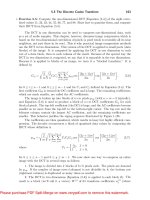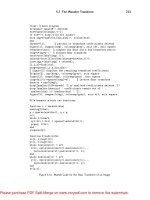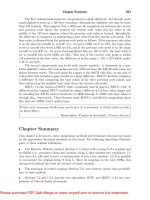a classical introduction to cryptography exercise book
Bạn đang xem bản rút gọn của tài liệu. Xem và tải ngay bản đầy đủ của tài liệu tại đây (8.94 MB, 262 trang )
A CLASSICAL INTRODUCTION
TO CRYPTOGRAPHY
EXERCISE BOOK
A CLASSICAL INTRODUCTION
TO CRYPTOGRAPHY
EXERCISE BOOK
Thomas Baignkres
EPFL, Switzerland
Pascal Junod
EPFL, Switzerland
Yi Lu
EPFL, Switzerland
Jean Monnerat
EPFL, Switzerland
Serge Vaudenay
EPFL, Switzerland
Springer
-
Thomas Baignbres
EPFL
-
I&C
-
LASEC
Lausanne, Switzerland
Yi Lu
EPFL
-
I&C
-
LASEC
Lausanne, Switzerland
Pascal Junod
Lausanne, Switzerland
Jean Monnerat
EPFL-I&C-LASEC
Lausanne, Switzerland
Serge Vaudenay
Lausanne, Switzerland
Library of Congress Cataloging-in-Publication Data
A C.I.P. Catalogue record for this book is available
from the Library of Congress.
A CLASSICAL INTRODUCTION TO CRYPTOGRAPHY EXERCISE BOOK
by Thomas Baignkres, Palcal Junod, Yi Lu, Jean Monnerat and Serge Vaudenay
ISBN- 10: 0-387-27934-2 e-ISBN-10: 0-387-28835-X
ISBN- 13: 978-0-387-27934-3 e-ISBN- 13: 978-0-387-28835-2
Printed on acid-free paper.
O
2006 Springer Science+Business Media, Inc.
All rights reserved. This work may not be translated or copied in whole or
in part without the written permission of the publisher (Springer
Science+Business Media, Inc., 233 Spring Street, New York, NY 10013,
USA), except for brief excerpts in connection with reviews or scholarly
analysis. Use in connection with any form of information storage and
retrieval, electronic adaptation, computer software, or by similar or
dissimilar methodology now know or hereafter developed is forbidden.
The use in this publication of trade names, trademarks, service marks and
similar terms, even if the are not identified as such, is not to be taken as
an expression of opinion as to whether or not they are subject to
proprietary rights.
Printed in the United States of America.
987654321 SPIN 1151441 1.1 1552901
To
Vale'rie and
my
parents
To
Mimi and Chloe'
To
my
parents
To
Susan and
my
parents
To
Christine and Emilien
Contents
Foreword
1. PREHISTORY OF CRYPTOGRAPHY
Exercises
Exercise
1
Mappings, etc.
Exercise 2 A Simple Substitution Cryptogram
Exercise
3
Product of Vigenkre Ciphers
Exercise
4
*One-Time Pad
Exercise 5 *Latin Squares
Exercise
6
Enigma
Solutions
2. CONVENTIONAL CRYPTOGRAPHY
Exercises
Exercise
1
Exercise 2
Exercise 3
Exercise
4
Exercise 5
Exercise
6
Exercise
7
Exercise 8
Exercise
9
Exercise 10
Exercise
11
Exercise 12
Exercise 13
Weak Keys of
DES
Semi-weak Keys of
DES
Complementation Property of
DES
3DES
Exhaustive Search
2DES
and Two-Key
3DES
*Exhaustive Search on
3DES
An Extension of
DES
to 128-bit Blocks
Attack Against the OFB Mode
*Linear Feedback Shift Registers
*Attacks on Cascade Ciphers
Attacks on Encryption Modes I
Attacks on Encryption Modes
I1
*A Variant of A511 I
xiii
viii
EXERCISE
BOOK
Exercise 14
*A Variant of A511 I1
Exercise 15 *Memoryless Exhaustive Search
Solutions
3.
DEDICATED CONVENTIONAL
CRYPTOGRAPHIC PRIMITIVES
Exercises
Exercise
1
Collisions in CBC Mode
Exercise
2
Collisions
Exercise
3
Expected Number of Collisions
Exercise
4
Multicollisions on Hash Functions
Exercise
5
Weak Hash Function Designs
Exercise
6
Collisions on a Modified
MD5
Exercise
7
First Preimage on a Modified
MD5
Exercise
8
*Attacks on Yi-Lam Hash Function
Exercise
9
MAC from Block Ciphers
Exercise 10
CFB-MAC
Exercise
11
*Universal Hashing
Solutions
4.
CONVENTIONAL SECURITY ANALYSIS
Exercises
Exercise
1
Exercise
2
Exercise
3
Exercise 4
Exercise
5
Exercise
6
Exercise
7
Exercise
8
Exercise
9
Exercise 10
Exercise
11
Exercise
12
Exercise
13
Solutions
The
SAFER
Permutation
*Linear Cryptanalysis
*Differential and Linear Probabilities
*Feistel Schemes
*Impossible Differentials
*Attacks Using Impossible Differential
*Multipermutations
*Ort homorphisms
*Decorrelation
*Decorrelation and Differential Cryptanalysis
*Decorrelation of a Feistel Cipher
*A Saturation Attack against
l
DEA
*Fault Attack against a Block Cipher
Contents
5.
SECURITY PROTOCOLS WITH
CONVENTIONAL CRYPTOGRAPHY
Exercises
Exercise
1
Flipping a Coin by Email
Exercise
2
Woo-Lam Protocol
Exercise
3
MicroMint I
Exercise
4
MicroMint I1
Exercise
5
Bluetooth Pairing Protocol
Exercise
6
UNIX Passwords
Exercise
7
Key Enlargement
Solutions
6.
ALGORITHMIC ALGEBRA
Exercises
Exercise
1
Exercise
2
Exercise
3
Exercise
4
Exercise
5
Exercise
6
Exercise
7
Exercise
8
Exercise
9
Exercise 10
Captain's Age
Roots in
Z;,
*When is
ZE
Cyclic?
Finite Fields and
AES
*A Special Discrete Logarithm
*Quadratic Residues
*Cubic Residues
*Generating Generators for
Z;
*Elliptic Curves and Finite Fields
I
*Elliptic Curves and Finite Fields
I1
Solutions
7.
ALGORITHMIC NUMBER THEORY
Exercises
Exercise
1
*Rho Method and Distinguished Points
Exercise
2
*Factorization
Exercise
3
*Prime Numbers
Exercise
4
*Factoring
n
=
p
-
q
Exercise
5
Strong Prime Numbers
Exercise
6
Complexity of Eratosthenes Sieve
Exercise
7
*Hash Function Based on Arithmetics
Solutions
x
EXERCISE
BOOK
8. ELEMENTS OF COMPLEXITY THEORY 175
Exercises
Exercise
1
*Regular Language
Exercise 2 *Finite State Automaton
Exercise 3 *Turing Machine
Exercise
4
*Graph Colorability I
Exercise 5 *Graph Colorability I1
Solutions 177
9. PUBLIC KEY CRYPTOGRAPHY 181
Exercises
Exercise
1
Exercise 2
Exercise 3
Exercise
4
Exercise 5
Exercise
6
Exercise
7
Exercise 8
Exercise 9
Exercise 10
*Okamoto-Uchiyama Cryptosystem
RSA Cryptosystem
RSA for Paranoids
RSA
-
Common Moduli
Networked RSA
Repeated RSA Encryption
Modified Diffie-Hellman
*Rabin Cryptosystem
*Paillier Cryptosystem
*Naccache-Stern Cryptosystem
Solutions 188
10. DIGITAL SIGNATURES 199
Exercises 199
Exercise
1
Lazy DSS 199
Exercise 2 *DSS Security Hypothesis 199
Exercise 3 DSS with Unprotected Parameters 200
Exercise
4
Ong-Schnorr-Shamir Signature 20
1
Exercise 5 Batch Verification of DSS Signatures 20
1
Exercise
6
Ring Signatures 203
Solutions 205
11.
CRYPTOGRAPHIC PROTOCOLS 211
Exercises 211
Exercise
1
Breaking the RDSA Identification Scheme 211
Exercise 2 *A Blind Signature Protocol for a Variant of
DS A 213
Contents
xi
Exercise 3 *Fiat-Shamir Signature
I
215
Exercise 4 *Fiat-Shamir Signature I1 216
Exercise 5 *Authenticated Diffie-Hellman Key Agreement
Protocol 216
Exercise 6 Conference Key Distribution System 217
Solutions 220
12. FROM CRYPTOGRAPHY TO
COMMUNICATION SECURITY
Exercises 231
Exercise
1
A Hybrid Cryptosystem Using RSA and
DES
231
Exercise 2 SSLITLS Cryptography 233
Exercise 3 Secure Shell (SSH) 235
Exercise 4 Attack against RC5-CBC-PAD 236
Exercise
5
Wired Equivalent Privacy (WEP) 237
Exercise 6 Forging X.509 Certificates 238
Solutions 240
References 249
Foreword
As a companion book of Vaudenay's
A
Classical Introduction to Cryp-
tography, this exercise book contains a carefully revised version of most
of the material used in teaching by the authors or given as examinations
to the undergraduate students of the Cryptography and Security lecture
at EPFL from 2000 to mid-2005. It covers a majority of the subjects that
make up today's cryptology, such as symmetric or public-key cryptogra-
phy, cryptographic protocols, design, cryptanalysis, and implementation
of cryptosystems.
Exercises do not require a large background in mathematics, since
the most important notions are introduced and discussed in many of the
exercises. We expect the readers to be comfortable with basic facts of
discrete probability theory, discrete mathematics, calculus, algebra,
as
well as computer science. Following
A
Classical Introduction to Cryp-
tography, exercises related to the more advanced parts of the textbook
are marked with a star.
The difficulty of the exercises covers a broad spectrum. In some the
student is expected to simply apply basic facts, while in others more in-
tuition and reflexion will be necessary to find the solution. Nevertheless,
the solutions accompanying the exercises have been written as clearly
as
possible. Some exercises are clearly research-oriented, like for instance
the ones dedicated to decorrelation theory or to very recent results in
the field of hash functions. The idea was to give to our readers a taste
of this exciting research world.
Chapter
1
is dedicated to the prehistory of cryptology, exposing the
design and the cryptanalysis of very simple and/or historical ciphers.
Chapter 2 investigates basic facts of modern symmetric cryptography,
focusing on the Data Encryption Standard, modes of operations, and
stream ciphers. Chapter
3
handles the hash functions topic, while Chap-
ter
4
describes some more involved notions of cryptanalysis of block ci-
xiv
EXERCISE
BOOK
phers. Chapter
5
considers protocols based on symmetric cryptography.
Chapter
6
is based on some basic facts of algebra and on the algorithms
used to compute within the usual algebraic structures used in cryptology,
while Chapter
7
is devoted to number theory with a strong emphasis put
on its algorithmic aspects. Chapter
8
is built around some elements of
complexity theory. Chapter
9
treats the important subject of public-key
encryption schemes and Chapter 10 contains exercises centered around
the notion of digital signatures. Chapter
11
exposes some protocols us-
ing public-key cryptography, and Chapter 12 handles the case of hybrid
protocols, combining both symmetric and public-key schemes.
A
website
(http:
//www
.
intro-to-crypto. inf o)
has been set up as a
companion of this book. It will contain inevitable errata as well as other
material related to this book, like challenging tests and more exercises.
Finally, the authors would like to thank Gildas Avoine, Matthieu
Finiasz, and all the
EPFL
students who attended at least one of our
lectures, as well as the Springer-Verlag staff for having provided us so
many useful comments on these exercises, their solutions, and on the
textbook.
We wish the reader a wonderful trip in the exciting world of cryptol-
O~Y!
Chapter
1
PREHISTORY OF CRYPTOGRAPHY
Exercises
Exercise
1
Mappings, etc.
The goal of this exercise is to remind the notions of function, injection,
surjection, bijection, permutation, and transposition. If any of those
notions is not clear to you, keep reading!
Consider the two sets X
=
{xl,xz,.
. .
,
x,) and
Y
=
{yl, y2,.
.
.
,
ym),
and a function
f
:
X
-
y.
As
f
is a function, it assigns to each element
of X
a
single element of
y.
1
If
n
<
m, can
f
be a function? What about the case where
n
>
m?
2
Consider the case where
n
=
3
and m
=
4.
Which of the following
diagrams represent a function? Explain why (or why not).
3
A
function
f
is said to be
1
-
1
(one to one), or injective, if each
element of
y
is the image of at most one element of X, i.e., for all
Xl,X2
E
X,
f
(~1)
=
f
(~2)
*
21
=
22.
2
EXERCISE
BOOK
Which of the following diagrams represent an injective function?
4
A
function
f
is said to be surjective if each element of
y
is the image
of at least one element of X, i.e., if for all
y
E
y
there exists an
x
E
X such that
f(x)
=
y.
When
f
is surjective, it is said to be a
function from X onto
y.
Which of the following diagrams represent
a surjective function?
5
If every element of
y
is the image of exactly one element of X, then
f
is called a bijection, i.e.,
f
is an injection and a surjection. Can
f
be a bijection if
n
>
m? What about the case where
n
<
m?
6
Show that if X and
Y
have the same cardinality and if
f
is an injec-
tion, then
f
is a bijection.
The last property is often used to show the bijectivity of a given function.
A
permutation on X is a bijection from
X
onto itself, i.e., a rearrange-
ment of the elements of
X.
In order for
f
to be a permutation, we must
have X
=
y.
Moreover, we let X
=
(0,
I)',
i.e., X is the set of all binary
sequences of length
t.
A
permutation on
X
that simply rearranges the
bits of its input is referred to as a transposition on X.
7
Does a permutation always preserve the Hamming weight of a se-
quence of
t
bits? Does a transposition?
Reminder:
The Hamming weight of a binary sequence is the number
of 1's in that sequence.
8
Can we say that a transposition is just a permutation on the bit
positions?
The Data Encryption Standard
(DES)
is a very famous and widely used
block cipher. It maps 64-bit plaintext blocks
x
=
(xG3xG2
. .
.
xO)
on
Prehistory
of
Cryptography
Figure
1.1.
DES,
a mapping of 64-bit plaintext blocks on 64-bit ciphertext block,
depending on
a
56-bit secret key
64-bit ciphertext blocks
y
=
(~6~~6~.
.
.
yo) using a 56-bit secret key
k
=
(k55 k54
.
. .
ko)
as
a parameter (see Figure 1.1).
9
When the secret key
k
is fixed,
DES
defines a specific permutation
on
X
=
(0,l)". Why do you think it is necessary for
DES
to be a
bijection, and not a simple function?
10 How many permutations can you find on
X
=
(0, 1)64? How many
different secret keys does
DES
have?
11
DES
internal design involves a 32-bit transformation which is repre-
sented in Figure 1.2. Is this transformation a permutation and/or a
transposition?
Consider now a random permutation on (0,
l)e
represented by a random
variable C*, uniformly distributed among all possible permutations of
{o,lIe.
12 Compute Pr[C*
=
c], where c is a fixed permutation on (0,
lie.
13 Let x, y
E
(0,
lJe
be two fixed Gbit strings.
Using the previous
question, compute Pr[C* (x)
=
y]
.
Compare this probability with
Pr[Y
=
y] where Y is a random variable uniformly distributed in
(0, qe.
14 Let a,
b
E
(0,
lIe
such that a
#
0. We define the diifSerentia1 proba-
bility of C* to be
DP'*
(a,
b)
=
Pr[C*
(X
@
a)
=
C*
(X)
@
b]
,
X
EXERCISE
BOOK
Figure
1.2.
A
transformation in
DES
on 32-bit strings
where the probability holds over the uniform distribution of
X.
For
b
#
0,
show that
1
E~.
(DP'*(~,
b))
=
-
2e
-
1.
D
Solution on page
8
Exercise
2
A
Simple Substitution Cryptogram
The following text is encrypted using a simple substitution method.
The plaintext is part of an English text
encoded
in upper case characters
without punctuation marks. Using the distribution of the characters in
English texts (see Table 1.1), recover the plaintext.
ODQSOCL OW GIU BOEE QRROHOCS QV GIUR KIA QF Q DQCQSLR WIR
ICL IW CQFQF EIYQE YIDJUVLR FGFVLDF GIU SLV OCVI GIUR
IWWOYL IC VXQV DICPQG DIRCOCS VI WOCP VXL JXICLF ROCSOCS
LHLRG YQEELR OF Q POFVRQUSXV YICWUFLP CQFQ BIRMLR QCP
LHLRG YQEELR QFFURLF GIU VXQV XOF IR XLR WOEL IR
Table
1.1.
Distribution of the characters in a typical English text
Letter Probability Letter Probability Letter Probability
Prehistory
of
Cryptography
5
QYYIUCVOCS RLYIRP IR RLFLQRYX JRIKLYV LHLRG ICL IW BXOYX
OF DOFFOCS WRID VXL YIDJUVLR FGFVLD OF QAFIEUVLEG HOVQE
D
Solution on page
11
Exercise
3
Product
of
Vigenere Ciphers
A
group (G,o) consists of a set
G
with a binary operation o on G
satisfying the following four properties:
(Closure)
a
o
b
E
G
for all a,
b
E
G
(Associativity)
a o
(b
o c)
=
(a o
b)
o c for all a,
b,
c
E
G
(Neutral element)
there exists e
E
G such that a o e
=
e o a
=
a
for all a
E
G
(Inverse element)
for any element
a
E
G there exists
a-'
E
G
such
that aoa-'
=
a-'oa
=
1
1
Let
l
be a positive integer. Let V be the set of all Vigenhre ciphers
of key length
e.
Denoting
o
the composition of two functions, prove
that
(V,
o)
is a group.
2
What is the product cipher of two Vigenhre ciphers with distinct key
length?
D
Solution on page 12
Exercise
4
*One-Time Pad
The One-Time Pad (also known
as
the Vernam Cipher and often
abbreviated as OTP) is defined
as
follows.
A
plaintext is considered
as a random variable
X
E
(0,
lIn,
where
n
is some positive integer.
It is encrypted with a uniformly distributed random key
K
E
(0,
lIn,
independent of X, using a bitwise XOR operation. The ciphertext is
thus
Y
=
X
@
K.
1
Prove that the OTP provides perfect secrecy.
2 Show why the OTP is insecure if the key is used more than once.
3 Show that the OTP does not provide information-theoretic security
if the key is not uniformly distributed in (0,
l)n.
D
Solution on page 13
6 EXERCISE
BOOK
Let n be a positive integer.
A
Latin square
of order n is an n
x
n matrix
L
=
(li,j)15i,jln
with entries
lilj
E
{I,
. . .
,
n), such that each element of
the set
(1,.
. .
,
n) appears exactly once in each row and each column of
L.
A
Latin square defines a cipher over the message space
X
=
(1,.
.
.
,
n)
and the key space
K:
=
(1,.
.
.
,
n), for which the encryption of a plaintext
x
E
X
under a key
k
E
K:
is defined by
y
=
Ck(x)
=
&,.
1
Find a Latin square
L
of order
4.
Using this matrix, encrypt the
plaintext x
=
3 with the key
k
=
2.
2 Prove that a Latin square defines a cipher which achieves perfect se-
crecy if the key is uniformly distributed, independent from the plain-
text, and used only once.
D
Solution on page 13
Exercise
6
Enigma
The Enigma machine is a symmetric electromechanical encryption
device which was used by the German army during World War
11.
The
secret key consists of the initial position of three rotors (each rotor has
26 different positions), and an electric connection which represents a per-
mutation on {a, b,
c,
.
.
.
,
z) with 14 fixed points and
6
non-overlapping
exchanges of two characters. For example,
lets a,
c,
d,
f,
j,
l,
n,
o,
r,
u,
v,
w,
x,
y
unchanged, maps
b
to
t
and
t
to
b,
e to
q
and
q
to e, etc.
A
toy Enigma machine (limited to 6 letters) is
represented in Figure 1.3.
Lampboard Kevboard Plugboard Rotor
1
Rotor
2
Rotor
3
Reflector
Figure
1.3.
An Enigma machine limited to
6
letters
Prehistory
of
Cryptography
1
How many different keys does the Enigma machine have?
2
What is the corresponding key length in terms of bits?
3
What is the average complexity of an exhaustive key search?
D
Solution on page
14
8
Solutions
EXERCISE
BOOK
Solution
1
Mappings,
etc.
1
The mapping
f
can be a function regardless of the cardinalities of
X
and y. The answer is
yes
in both cases.
2
Diagram (a) does not represent a function
as
xl is mapped on two
different elements of y. Diagram (b) represents a function which
is not defined on
X
but only on a subset of
X.
Diagram (c) does
represent a function (which is not injective by the way
.
.
.
).
3
Diagram (a) does not represent an injective function as both xl and
x2 are mapped on yl, i.e.,
f
(XI)
=
f
(x2) with xl
#
x2. Diagram (b)
does represent an injection but Diagram (c) does not.
4
Diagrams (a) and (c) do not represent a surjective function. Diagram
(b) is not a surjection
as
y2 is not the image of any element of
X.
5
It is impossible to find a bijection between two sets of different car-
dinalities. The answer is
no
in both cases. Note that a usual way
to prove that two given finite sets have the same cardinality is to
explicitly construct a bijection from one onto the other. Also note
that proving that a function is a bijection can be done by finding its
inverse, i.e., finding a map
f
-'
:
y
-+
X
such that
(f
-l
o
f
)(x)
=
x
for all x
E
X.
6
First note that in a general case, if A and
B
are two finite sets such
that A
c
B
and IAl
=
IB1, then A
=
B.
Now, as
f
is injective, if
XI,
x2
E
X
such that xl
#
x2, we have
f
(xl)
#
f
(x2). If
n
=
I
X
I
=
lyl,
taking the image of the elements of
X
=
{XI,
22,.
.
.
,
x,), we
obtain a list of
n
elements
{
f
(xl),
f
(xz),
. . .
,
f
(x,))
y.
As
f
is
injective, we know that these
n
elements are distinct. Therefore
We have shown that every element of
y
is the image of an element
of
X
which makes
f
a surjective function. As
f
was also assumed to
be injective, it is finally bijective.
7
A permutation does not always preserve the Hamming weight of a
sequence. Here is a counterexample. Take
Prehistory of Cryptography
e
bits
where
Ic
is the binary representation of
1,
i.e.,
k
=
0.
.
.01. This
function is indeed a permutation. This should be clear from the fact
that
f
-'
=
f
(this is called an involution). We note that
f
maps the
binary representation of 0 onto the binary representation of
1.
As
these two sequences do not have the same Hamming weight, we have
found a counterexample. Finally, as a transposition is a particular
permutation which simply rearranges the bits of an input string, it
should be clear that a transposition preserves the Hamming weight.
8
Yes. Formally, we recall that a permutation
P
on (0,
lIe
is a bijection
from (0,
lIe
to (0,
lie.
We also give the definition of a transposition
thereafter, in a formal way. Let
T
:
(0,
lIe
+
(0,
1)l
be a permuta-
tion. We say that
T
is a transposition if and only if there exists a
permutation
a
on {1,2,3.
. .
,
l)
such that
Moreover, we notice that the number of transpositions on (0,
l)e
is
equal to the number of all permutations on {1,2,3
. .
.
,
t),
namely l!.
9
One desired property of a block cipher is to have the ability to decrypt
what it can encrypt, and this should be done with no ambiguity.
Therefore, for each
k
defining a permutation DESk, there should exist
DES~'
such that
DES~'(DES~(X))
=
x for all
x
E
{0,1)~~. This
property can only be guaranteed if DESk is a bijection for any key.
10 The number of permutations on a set of
N
elements is
N!.
Therefore,
there are 264! permutations on
X
=
{0,1)~~. There are 256 DES secret
keys.
11
This transformation is a simple reordering of the input bits. It is a
transposition. Strangely, it is always referred as the DES permutation
on 32 bits.
12 The random variable C* is uniformly distributed among a set of 2e!
elements (i.e., the permutations of (0,l)'). Therefore
13 Using the chain formula, we can see that
10
EXERCISE
BOOK
Obviously,
Cc
is the number of permutations of (0,
lIe
having
the property to map
x
onto
y.
"->
set
of
2'
-
1
elements
Noticing that this number is exactly the number of permutations of
a set of 2e
-
1
elements, that is (2'
-
I)!, we obtain
-
(2l
-
I)!
Pr[C* (x)
=
y]
-
2e!
14 If
b
=
0, then it is easy to see that DPc*(a,
b)
=
0, and thus
Ec* (DPC* (a,
b))
=
0. We now assume that
b
#
0. We have
Ec*
(DPC*
(a,
b))
=
Ec*
(P~[c*
(X
CB
a)
=
C* (X)
$
b]
X
as C* is uniformly distributed. We denote
y
=
x$a. As a
#
0,
y
#
x.
With this notation,
As
b
#
0, the inner sum is the number of permutations mapping
x
onto
a
and
y
onto
a
$
p,
which is (2e
-
2)!. Consequently,
Prehistory
of
Cryptography
We conclude that
C*
1
Ec*
(DP
(a,
b))
=
-
2"
1'
Solution
2
A
Simple Substitution Cryptogram
The character distribution in the ciphertext is given in Table 1.2.
Using this information and comparing it with the character frequency
table, it is possible to isolate the most frequent characters in the cipher-
text. If we consider the digrams and trigrams frequency mentioned in
the textbook [56] and if we take advantage of the fact that there are not
that many
2
letter and 3 letter words in English, we get (not without
work!) the key represented on Table 1.3. The decrypted ciphertext 1161
Table
1.2.
Distribution of the characters in the ciphertext
Letter Probability Letter Probability Letter Probability
IMAGINE IF YOU WILL ARRIVING AT YOUR JOB AS A MANAGER FOR
ONE OF NASAS LOCAL COMPUTER SYSTEMS YOU GET INTO YOUR
OFFICE ON THAT MONDAY MORNING TO FIND THE PHONES RINGING
EVERY CALLER IS A DISTRAUGHT CONFUSED NASA WORKER AND
EVERY CALLER ASSURES YOU THAT HIS OR HER FILE OR
ACCOUNTING RECORD OR RESEARCH PROJECT EVERY ONE OF WHICH
IS MISSING FROM THE COMPUTER SYSTEM IS ABSOLUTELY VITAL
or, in a more formatted manner:
Imagine, if you will, arriving at your job
as
a manager for one of NASA's
local computer systems. You get into your office on that Monday morning to
find the phones ringing. Every caller is a distraught, confused NASA worker.
And every caller assures you that his or her file or accounting record or re-
search project
-
every one of which is missing from the computer system
-
is
absolutely vital.
12
EXERCISE
BOOK
Table
1.3.
The key of the simple substitution
Solution
3
Product of Vigengre Ciphers
Let k and k' denote two keys of
t
characters and let Ck and Ckl
denote their corresponding Vigenkre ciphers. A VigenBre cipher encrypts
a message x by adding character-wise a key modulo 26.
If x is some
plaintext of length d, then y
=
Ck(x) where
yi
=
xi
+
ki
mod
e
mod 26
for all
i
=
0,
,d
-
1.
1
In order to prove that
(V,
o)
is a group, we have to check
four
prop-
erties:
rn
(Closure)
We have to show that there exists some key
k"
such
that Ckl1
=
Cp
o
Ck. As the addition modulo 26 is an associative
operation, if y
=
(Ckl
o
Ck)(x)
=
Cp(Ck(x)) then
yi
=
xi
+
(ki
mod
e
+
ki
e
mod 26) mod 26
for all
i
=
0,.
. .
,
d
-
1.
Thus, if k"
=
k
+
kt mod 26 (the modular
addition being evaluated character-wise), Ck1t
=
Cp
o
Ck. This
proves that encrypting twice with the VigenBre cipher is not more
secure than a single encryption.
rn
(Associativity)
The fact that (Ck oCk1) oCku
=
Ck
o
(Ckl oC,y~) is
a direct consequence of the associativity of the modular addition.
rn
(Neutral element)
We have to show that there exists a key
under which a Vigenkre encryption is the identity function. It is
easy to check that this is the case of the key k,
=
AA
.
A.
rn
(Inverse element)
We have to show that to each key k corre-
sponds a key kt such that Cp
o
Ck is the identity. This is the case
when kb
=
-ki mod 26 for all
i
=
0,.
. .
,
t
-
1.
Encrypting with
the inverse is thus equivalent to decryption.
Prehistory of Cryptography
13
2
The product cipher of two Vigenkre ciphers
Ck
and
Cp
having key
length
l
and
l'
respectively is equivalent to a Vigenkre cipher
Ckll
with a key length
l"
=
lcm(l, l'). Namely,
l"
must be a multiple of
both
l,
l'
and must be the smallest integer satisfying this property.
Solution
4
*One-Time Pad
1
The OTP provides perfect secrecy if the plaintext and the ciphertext
are independent, i.e., if Pr[X, Y]
=
Pr[X] Pr[Y]
.
If n denotes the
size of the key, we have
where the independence of X and K was used in the second equality.
Moreover,
which concludes the proof.
2
Suppose we encrypt two messages x and x' with the same key k. If we
add the two corresponding ciphertexts, we get x@k$x'@k
=
x@xl. If
x
and x' are ASCII texts written in a certain language (for instance),
it is possible for an adversary to recover x and x' by exploiting their
natural redundancy.
3
From information theory we know that
H(K)
L:
n, with equality if
and only if
K
is uniformly distributed. Since perfect secrecy implies
that H(X)
<
H(K) (for any distribution of X), there is a contradic-
tion if H(K)
<
n, as H(X)
5
H(K) would not hold for a uniform
distribution of X.
Solution
5
*Latin Squares
1
An example of Latin square of order
4
is









